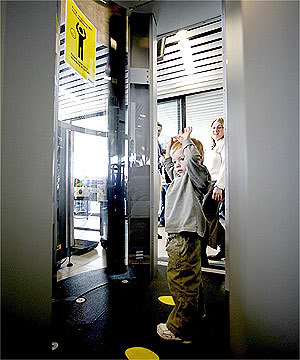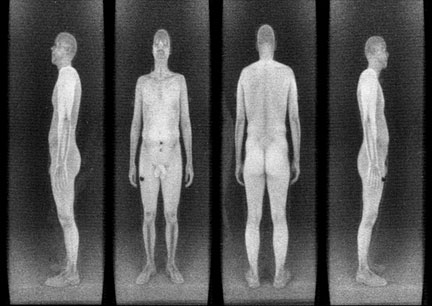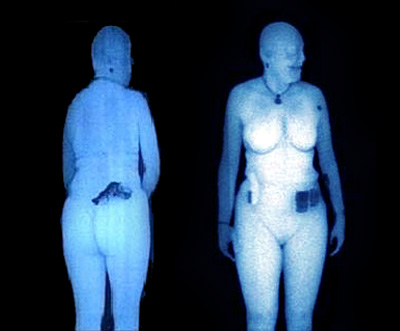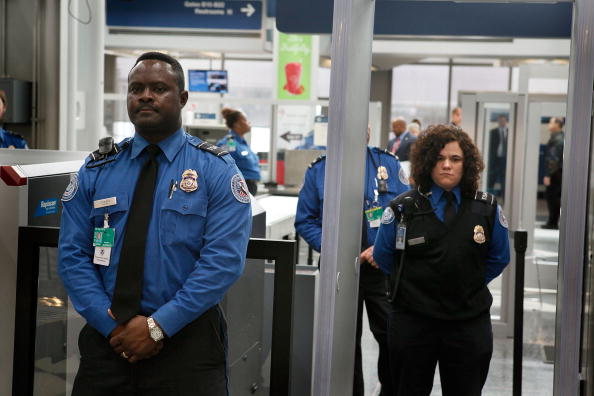|
TSA Through-the-Clothes Scanners and pat-downs are by definition sexual abuse This issue of TSA through the clothing imaging scans and advanced ‘pat downs’ troubles me to such an extent that I feel I must speak out through my communication methods. I hear many others who also disagree, but who are unable to articulate their positions. While I have personal grievances of my own against the invasion of my privacy, I am more concerned with legal issues surrounding the violation of rights and laws against others. I will not cite any 4th amendment concerns here. Those are being loudly represented by the media and other sources. 1. Sexually explicit images of children under 18 - are they legal?
Of primary concern are the minor children who are being photographed or imaged and viewed through their clothes. These image of children through their clothing are inviolation of federal laws against photographing children under 18. Regardless of whether such an image is distributed, saved or transmitted is immaterial. Th United States Penal Code states the following ver batim as pertaining to issues of crimes against children. United States Code Title 18 > Part 1 > Chapter 17: § 1466A. Obscene visual representations of the sexual abuse of children Defines (1) the term “visual depiction” includes undeveloped film and videotape, and data stored on a computer disk or by electronic means which is capable of conversion into a visual image, and also includes any photograph, film, video, picture, digital image or picture, computer image or picture, or computer generated image or picture, whether made or produced by electronic, mechanical, or other means. As stated in US Code Title 18 > Part I / Chapter 110 > § 2556, For the purposes of this chapter, the term— (1) “minor” means any person under the age of eighteen years; (2) (A) Except as provided in subparagraph (i) sexual intercourse, including genital-genital, oral-genital, anal-genital, or oral-anal, whether between persons of the same or opposite sex; (ii) bestiality; (iii) masturbation; (iv) sadistic or masochistic abuse; or (v) lascivious exhibition of the genitals or pubic area of any person; In the instance of these Whole Body through-the-clothes TSA scanning images, “exhibition of the genitals or pubic area” occurs very clearly. 2. Children under 18 are below the age of consent; cannot agree to touching and are without protection from sexual abuses. Those who are imaged; or the families of those who are imaged have no assurances whatsoever that the viewer is not a sex offender, or would perceive the image in a sexual manor. This is impossible to offer protection against. The U.S. Department of Justice, Bureau of Justice Statistics on Child Sexual Abuse reports that only 40% of convicted sex offenders are currently imprisoned. Just this year, TSA employee, Sean Shanahan was arrested on charges of raping a 14 year-old girl. A TSA spokeswoman says Shanahan passed two background checks and there are no passenger complaints on record against him. Shanahan worked for the TSA since 2006. He is not the only sex offender discovered to be a TSA employee.  A minor child who might avoid being imaged through his or her clothes and instead encounters the pat-down is subjected to touching against his or her will. A minor child under 18 is not able to offer his consent to touching. This is the same way a minor child is unable to give consent to sexual acts. A parent can also not offer consent on behalf of a minor child for this kind of touching. That would be akin to a parent giving permission for another person to engage in sexual relations with the minor child. The two ideas are equally absurd and offensive. Every year, thousands of children travel as unacompanied minors, which means they are experiencing these scans with no parental supervision. Should one of these children fall victim to touching or molestation by a TSA worker, that child has no parent to report or advocate on his or her behalf. A minor child who might avoid being imaged through his or her clothes and instead encounters the pat-down is subjected to touching against his or her will. A minor child under 18 is not able to offer his consent to touching. This is the same way a minor child is unable to give consent to sexual acts. A parent can also not offer consent on behalf of a minor child for this kind of touching. That would be akin to a parent giving permission for another person to engage in sexual relations with the minor child. The two ideas are equally absurd and offensive. Every year, thousands of children travel as unacompanied minors, which means they are experiencing these scans with no parental supervision. Should one of these children fall victim to touching or molestation by a TSA worker, that child has no parent to report or advocate on his or her behalf. These minor children are unable to give consent to such images being taken and viewed of them through their clothing, or to the pat down which includes touching their private areas. This also reveals another critical legal issue regarding consent to the screening as acceptance of terms of travel. If the passenger agrees to such screening as terms of travel, the minor child is not able to do so legally on his or her own behalf. A minor child cannot enter into such a contract or accept these terms. Therefore, the current regulation suggests again that a parent is accepting these terms on behalf of the minor child. Once again, the minor child has no choice or opportunity to refuse the scan or the pat down and is forced to participate as a third party. Certainly arguments can be made that a terrorist would use a minor child in an act of terrorism. However, citing that another party is abusing children is not sufficient rationalization to further abuse the rights of children.
3. Acceptance of screening methods as terms of participation in flights? Regarding the acceptance of the objectionable screening methods in terms and conditions of participating in the flight, there exist many examples for those who are unable to have legally accepted these terms and conditions. Elderly passengers, mentally challenged or mentally ill passengers are not able to understand that these security measures are terms of participation in the flight. Typically these passengers’ flights are even purchased on their behalf. In other words, many adult persons lack the ability to accept or refuse being photographed through their clothes or invasive touching of their private areas. Third party flight participants as well have not accepted the security measures as terms for participation. Employees who are taking flights as a part of their work requirements typically do not purchase their own tickets; and are not consulted or able to refuse the security measures. Furthermore these employees who fly as a job requirement lack the ability to refuse participation due to their employment status. An employer likewise does not have the authority to require an employee to be subjected to unwanted touch or being photographed through their clothes. That employer would be sued for sexual harassment should an employee be scanned through his clothes or touch employees in an unwanted way as a part of his or her job requirements. This legally burdens employers to face legal ramifications associated with the purchase of employee flights as part of any job description or assignment. 4. Trauma and harm to certain passengers with medical or mental health concerns. Many passengers may have specific or personal health or emotional issues which would cause these screening measures to inflict significant personal harm or trauma. In addition to the large amounts of high radiation passengers are subjected to (more than a chest X-ray); some persons with conditions such as anxiety disorders or paranoia could experience unknown adverse affects of the touching, or even witnessing other passengers being touched against their will.
Additionally, adult victims of sexual abuse would too be traumatized by these experiences. It is estimated that as many as 40 million Americans, one in six people, experienced sexual victimization as children. Add these 40 million Americans to those who are traumatized when forced to be photographed through their clothes and /or be touched against their will in private areas and the situation is clearly of grave concern. 5. The very nature of these procedures precisely relate to the actual definition of sexual abuse. • Non-consensual, forced physical sexual behavior • Unwanted touching, either of a child or an adult. • The use of a position of trust to compel otherwise unwanted sexual activity without physical force
6. Exposure to Liability Should a passenger behave in a sexual manor or in some unusual circumstance such that can occur from time to time; allow more sexual contact between a TSA screener and a passengers’ private parts, liability is present. Should a sex offender be found to have been employed in any of these positions whereas he would see or screen images of persons through their clothes; to give pat-downs or even to have authority to coerce passengers to participate against their will for either, liability exists. Should a passenger who is a survivor of sexual abuse is traumatized by the experience, that passenger may bring suit against these agencies and companies. Employees may sue their employers who would ask them to be exposed to these procedures. Passengers traveling on tickets purchased by any third party might have cause to sue the ticket purchaser for an unwanted exposure to being photographed through their clothing or unwanted touch.
Effectiveness National security is of great concern to all air passengers. Real attempts have been made to harm and terrorize passengers aboard commercial flights within the US and abroad. These through the clothing body scans have not demonstrated that any incidents have been averted by their presence; or that they could have detected substances used in the past in prior attempts. Certainly as publicity images demonstrate, a through the clothing scanner would detect a firearm or knife, but these can easily be detected by a simple metal detector. A dedicated terrorist who wishes to smuggle explosives onto the flight will always have a choice of several body cavities in which to smuggle arms or explosives. These scanners offer no protection against this or many other crafty methods a terrorist might use. Sadly, each generation of screening added is known to a terrorist, so he or she may always use this information to adjust his or her plan to smuggle contraband aboard. The fine work of the other areas of crime prevention and intelligence have done an outstanding job in past events; to preclude success by earlier attempts. These included intelligence on the ground, alert passengers and flight crews. Weighing offenses against us vs. offenses of our own. The threat to our nation is real. TSA is charged with a daunting task of prevention of devises and plots which might do real tangible harm to a large number of passengers. The agency must perform due diligence and act to the highest level of security screening feasible. At question is the level of that feasibility. The feasibility was once limited by our technological ability to probe deeper. Today, that limit to feasibility comes in the legality and morality of procedures that could possibly, themselves do harm to the passenger through emotional or physical trauma; to break constitutional laws against unwarranted searches; to break federal laws against photographing of genitals of children under 18; to possibly expose images of unwitting persons to sexual offenders, to harm passengers by coercing them into unwanted touching or scanning through coercion and control; and by exposing participating parties and agencies to excessive liability risk. How much harm is the US Government willing to risk in engaging in these invasive and controversial policies which cannot guarantee unconditional safety? As I am a citizen of the United States, I am here to denounce such activity by my government, which I feel is unlawful and is harming people each day that this procedure is employed. Jen Winter, Business Owner |



 More seriously, a rape survivor who is required to be photographed through his or her clothes or to receive an advanced pat down would be significantly traumatized by such an experience. According to the NationalCrime Victimization Survey. Bureau of Justice Statistics, U.S. Department of Justice, 1996, 354,670 women were the victims of a rape or sexual assault in 1995 alone. There were 71 forcible rapes per 100,000 females reported to United States law enforcement agencies in 1996. By forcing rape survivors to be imaged through their clothes or touched in private areas against their will, these persons are being victimized again and again through government mandate.
More seriously, a rape survivor who is required to be photographed through his or her clothes or to receive an advanced pat down would be significantly traumatized by such an experience. According to the NationalCrime Victimization Survey. Bureau of Justice Statistics, U.S. Department of Justice, 1996, 354,670 women were the victims of a rape or sexual assault in 1995 alone. There were 71 forcible rapes per 100,000 females reported to United States law enforcement agencies in 1996. By forcing rape survivors to be imaged through their clothes or touched in private areas against their will, these persons are being victimized again and again through government mandate. TSA agents are elevated to a position of such authority that passengers loose the right to protest this unwanted imaging or touch above and beyond the contractual relationship of the ticket. Due to their position of authority, TSA Agents may coerce passengers by means of badgering, humiliation, detention, bullying, threats of ejection and fines for failing to engage in these activities which a passenger may not agree to. A passenger who is uncomfortable with a through the clothing scan or a pat down would be unduly coerced into doing so by this position of control. In the instance of other trades or industries such as a doctor or trades-person who has occasion to touch a patient or client, that client has the choice to refuse that unwanted touching; whether the touching is legal or illegal. The patient or client is in control over his or her own person and may refuse the exam or leave the office once that person becomes uncomfortable. A passenger who becomes uncomfortable while engaging a TSA agent does not have this capacity. That person faces badgering, bullying, detention, humiliation or steep fines if he or she declines the scan or the unwanted touch. Again, this is the precise definition of sexual abuse and/or harassment.
TSA agents are elevated to a position of such authority that passengers loose the right to protest this unwanted imaging or touch above and beyond the contractual relationship of the ticket. Due to their position of authority, TSA Agents may coerce passengers by means of badgering, humiliation, detention, bullying, threats of ejection and fines for failing to engage in these activities which a passenger may not agree to. A passenger who is uncomfortable with a through the clothing scan or a pat down would be unduly coerced into doing so by this position of control. In the instance of other trades or industries such as a doctor or trades-person who has occasion to touch a patient or client, that client has the choice to refuse that unwanted touching; whether the touching is legal or illegal. The patient or client is in control over his or her own person and may refuse the exam or leave the office once that person becomes uncomfortable. A passenger who becomes uncomfortable while engaging a TSA agent does not have this capacity. That person faces badgering, bullying, detention, humiliation or steep fines if he or she declines the scan or the unwanted touch. Again, this is the precise definition of sexual abuse and/or harassment. Should at some time in the future, a court should render a decision calling these procedures scanning passengers through their clothing and/or touching private areas sexual abuse or harassment, the exposure to liability is vast. The potential liability extends from the Government to Airports, to individuals employed by TSA, to the airline, to the travel agent who booked a ticket and/or any person who bought any ticket for any person who was subjected to these procedures. An employee of TSA who was required, through his or her job to view images of passengers through their clothes or who was asked to touch the private areas of passengers might themselves sue TSA.
Should at some time in the future, a court should render a decision calling these procedures scanning passengers through their clothing and/or touching private areas sexual abuse or harassment, the exposure to liability is vast. The potential liability extends from the Government to Airports, to individuals employed by TSA, to the airline, to the travel agent who booked a ticket and/or any person who bought any ticket for any person who was subjected to these procedures. An employee of TSA who was required, through his or her job to view images of passengers through their clothes or who was asked to touch the private areas of passengers might themselves sue TSA.